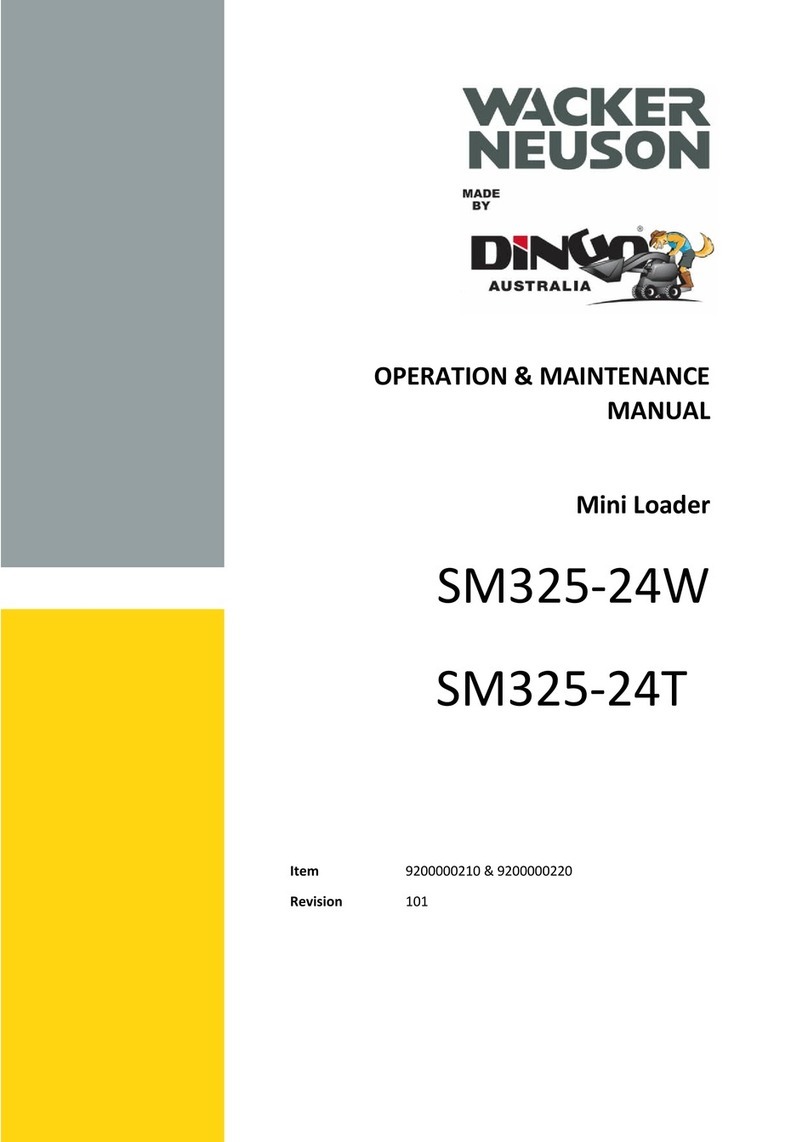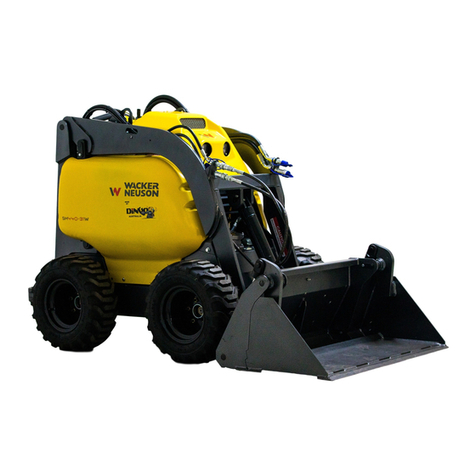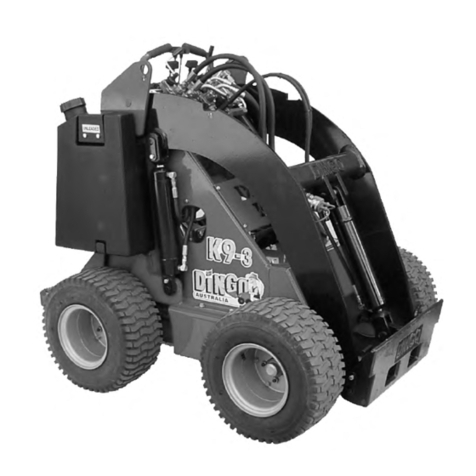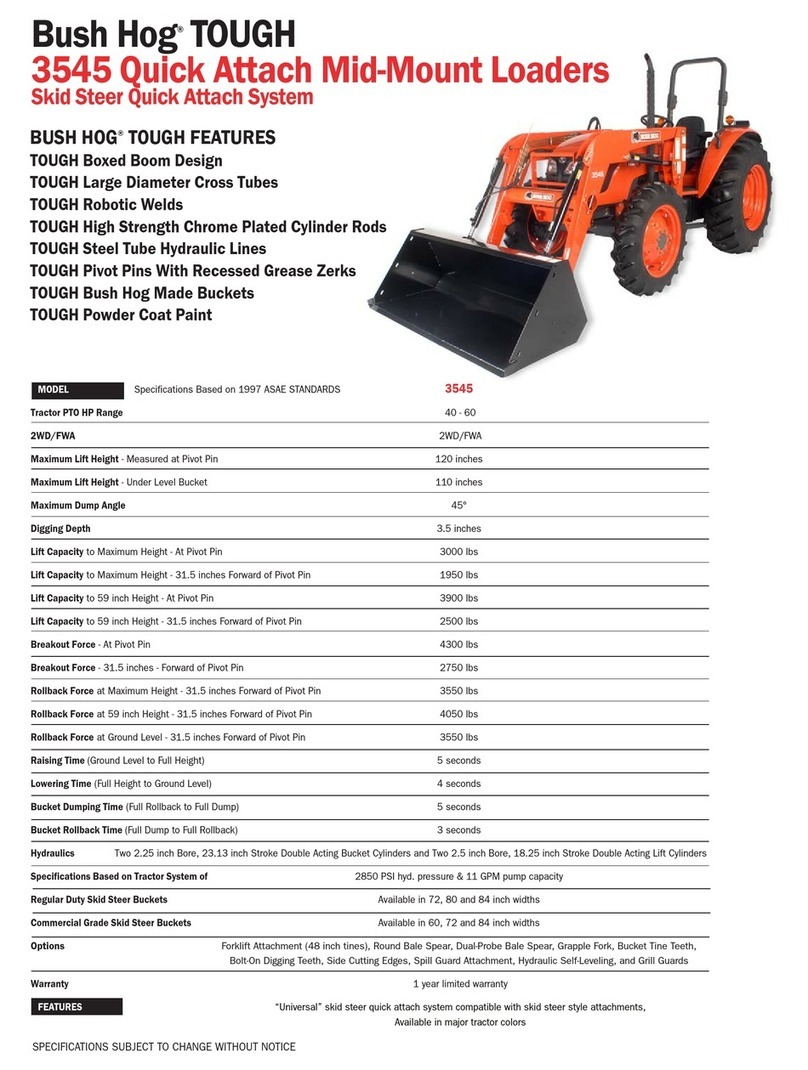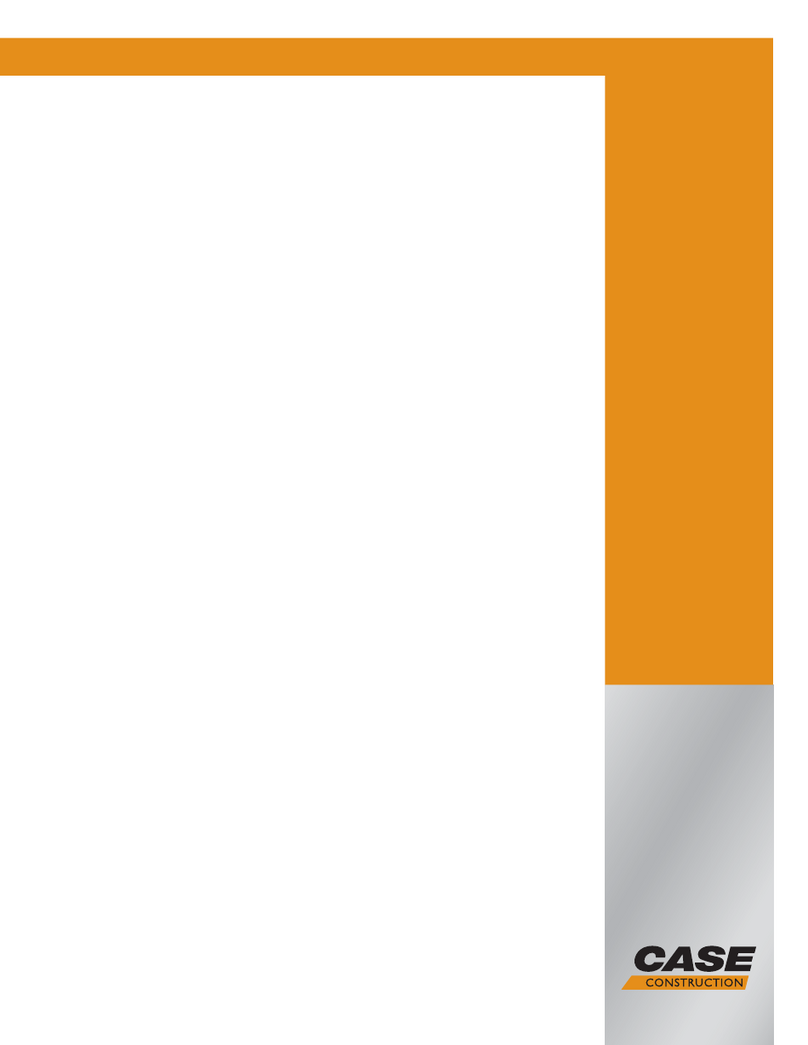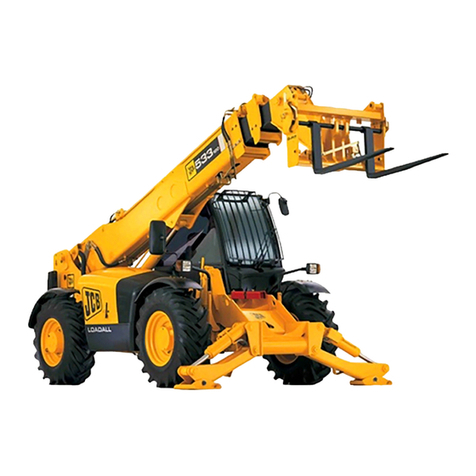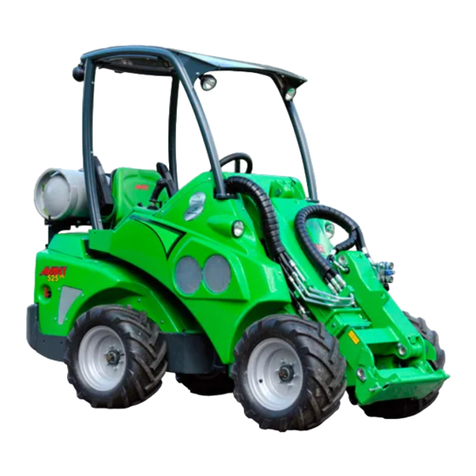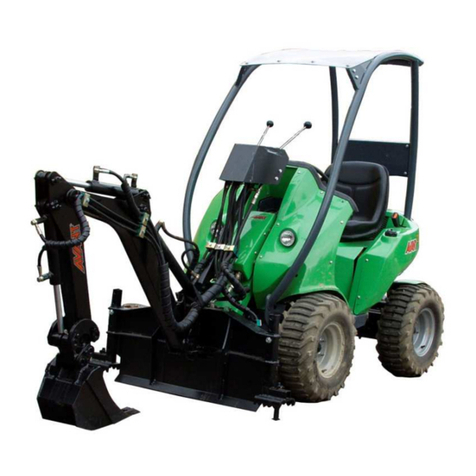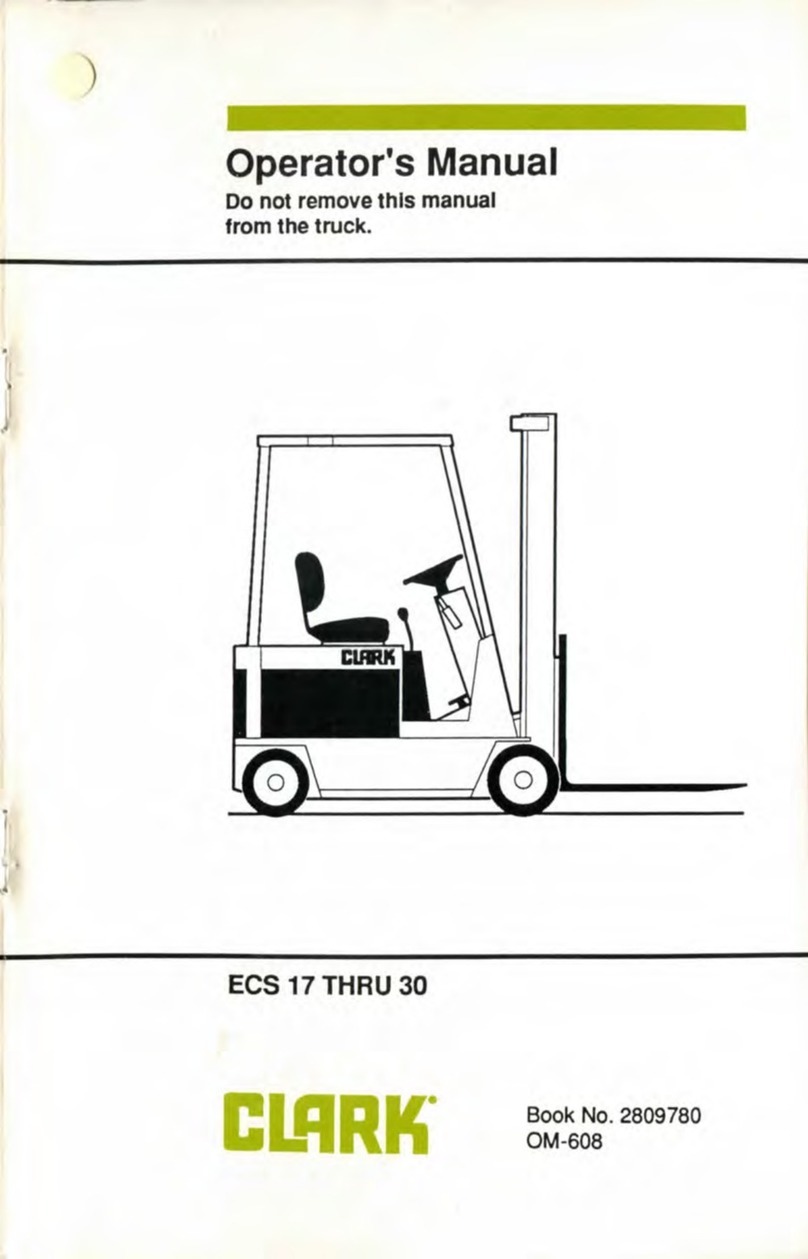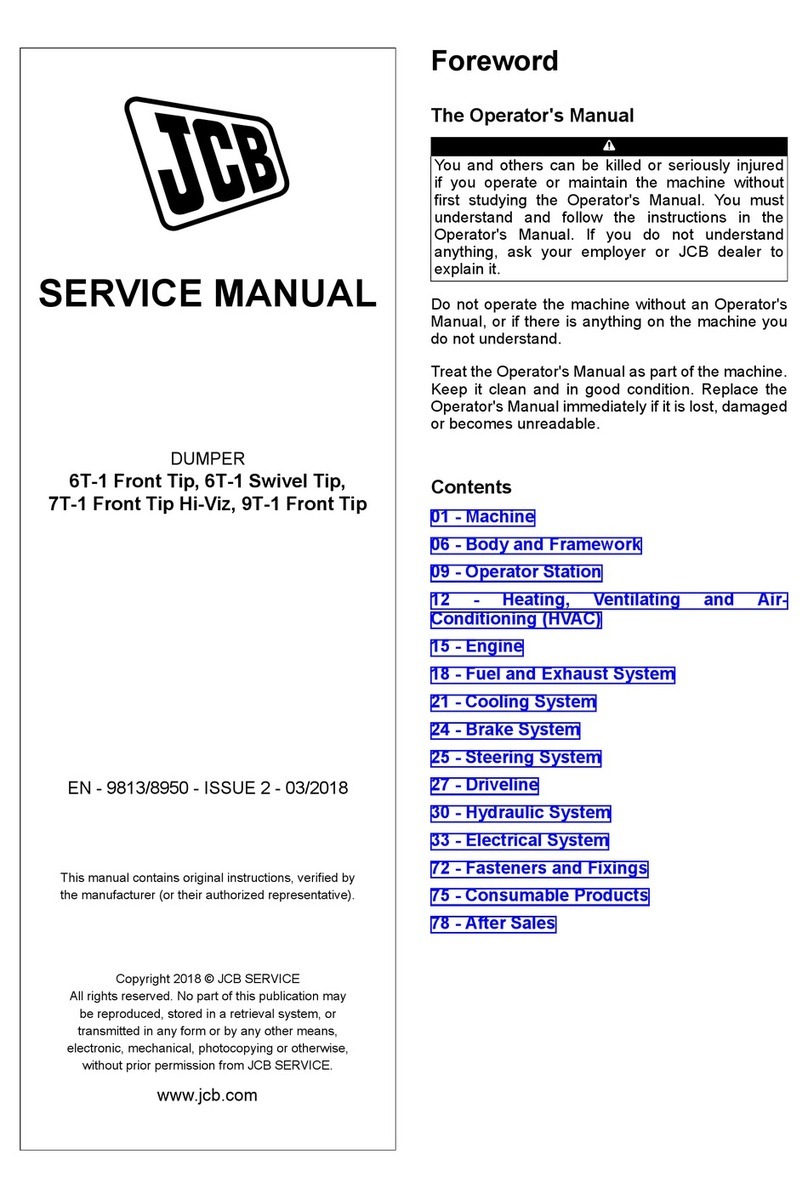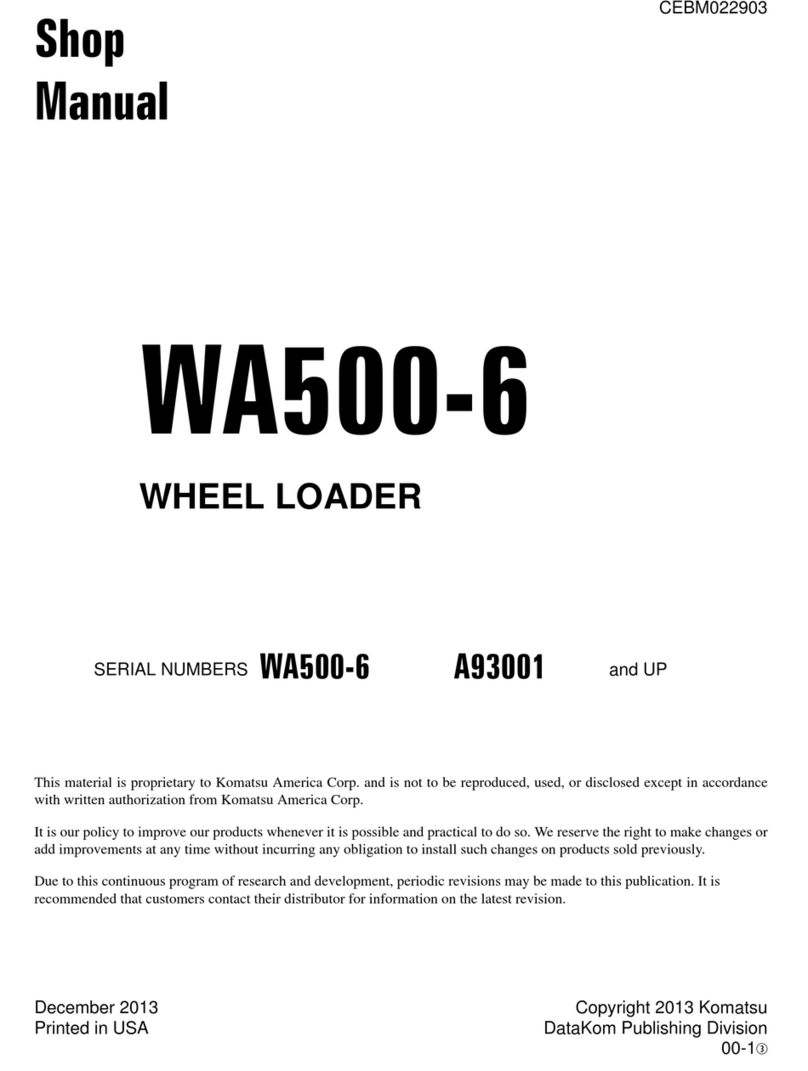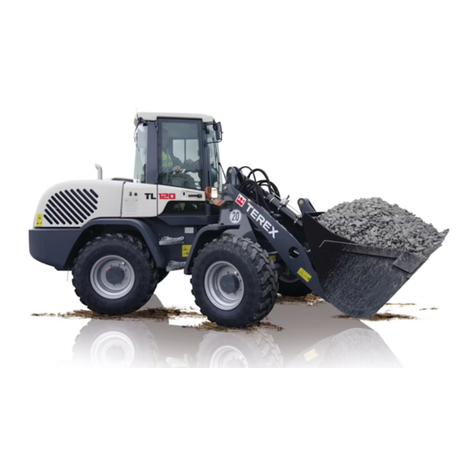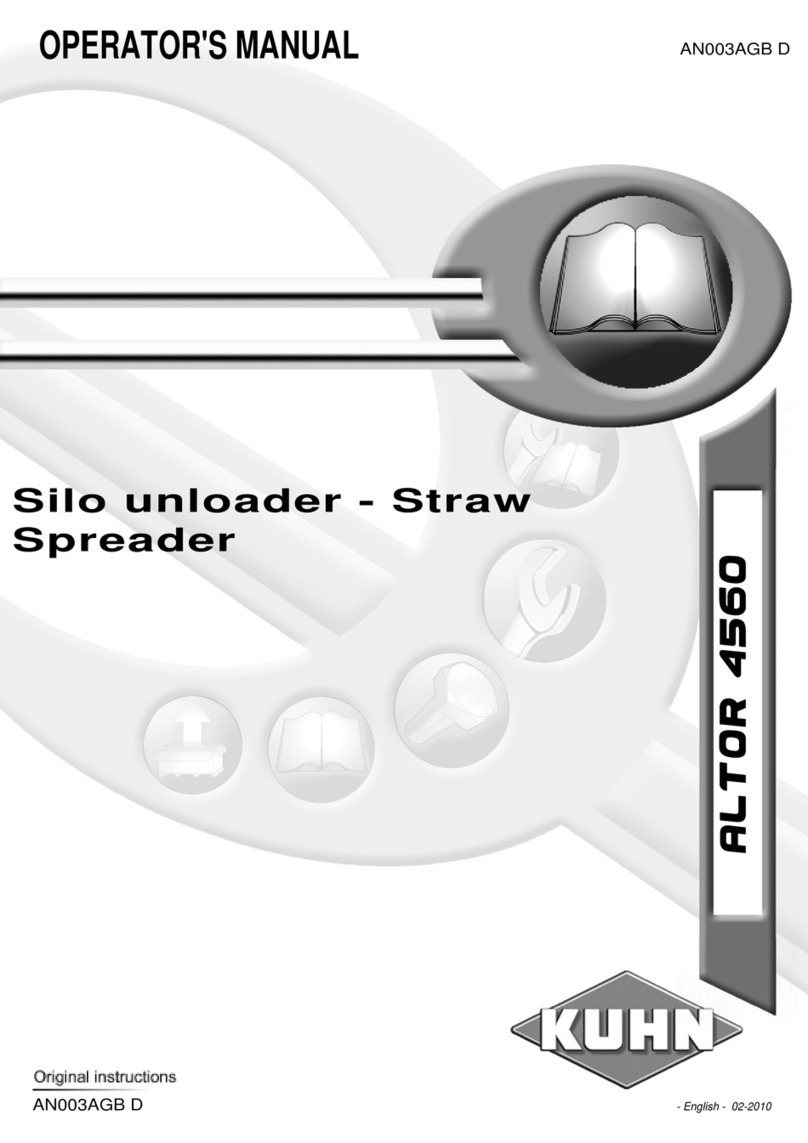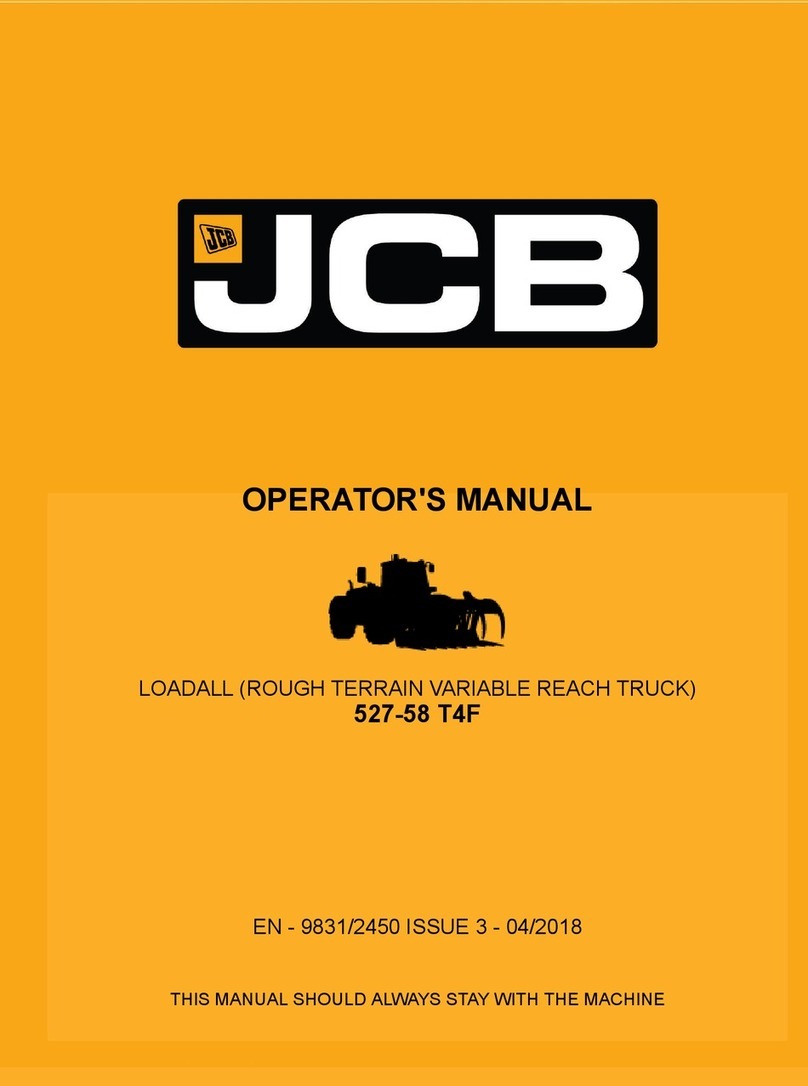DINGO 950 User manual

DINGO™ 950
OPERATION AND
MAINTENANCE
MANUAL
IMPORTANT: Become familiar with the
contents of this Manual before operating
the Dingo. It contains Safety Instructions
& Warranty Information. Also become
familiar with the controls & their proper
use before operating the Dingo.
Edited February 2004

Dingo 950 Operation & Maintenance Manual
2

Dingo 950 Operation & Maintenance Manual 3
Introduction
Thank-you for purchasing a Dingo.
We believe that in purchasing a Dingo you have purchased a machine of the highest
quality and we want you to be totally satisfied as our customer. Please feel free to
contact any of our branches for help with service, genuine replacement parts, or other
information you may require.
When contacting us please have your Dingo Chassis and Model numbers handy.
These details enable us to know the specifications of your Dingo.
Best Wishes,
Gary Briggs
And the entire Dingo Pack.
This Manual belongs with Dingo:-
Dingo Chassis Number
Dingo Model Number
Engine Type & Serial Number
Date Purchased
(Please insert your Dingo details)
Attachments
Item Model Number Chassis / Serial Number
(Please insert your attachment details)

Dingo 950 Operation & Maintenance Manual
4
Table of Contents
SAFETY________________________________________________ 5
General Operation___________________________________________________5
Operating on Slopes _________________________________________________6
Children __________________________________________________________6
Service ___________________________________________________________7
SAFETY AND INSTRUCTION DECALS____________________ 8
SPECIFICATIONS ___________________________________ 8
SPECIFICATIONS_______________________________________ 9
OPERATING INSTRUCTIONS – Pre Start-up ______________ 11
Pre start-up (daily) _________________________________________________11
Adding Fuel ______________________________________________________11
Checking the Oil Level. _____________________________________________12
Remove debris from the machine ______________________________________12
Check hydraulic fluid _______________________________________________12
Tyres and Traction _________________________________________________13
OPERATING INSTRUCTIONS___________________________ 14
Controls__________________________________________________________14
Control levers/ Control panel _________________________________________15
Control panel diagram_______________________________________________16
Flow divider control ________________________________________________17
Starting and stopping the Engine ______________________________________17
Driving forward or backward _________________________________________17
Stopping the machine _______________________________________________18
Moving a Non functioning machine ____________________________________18
Using Cylinder Locks _______________________________________________18
Attachments - Connecting & Disconnecting______________________________19
Transporting and securing____________________________________________20
Maintenance ___________________________________________ 21
Dingo Service Pack_________________________________________________23
Air Cleaner _______________________________________________________23
Bushes & Pins_____________________________________________________23
Engine Oil________________________________________________________24
Spark Plugs _______________________________________________________24
Fuel Filter ________________________________________________________24
Fuel Tank ________________________________________________________25
Hydraulic System __________________________________________________26
Replacing the Hydraulic Filter ______________________________________26
Changing the Hydraulic Fluid_______________________________________26
Check hydraulic lines _____________________________________________26
Adjusting Drive Chains______________________________________________27
Battery___________________________________________________________27
Cleaning and long term storage _______________________________________28
Troubleshooting ________________________________________ 29

Dingo 950 Operation & Maintenance Manual 5
SAFETY
General Operation
1. Read, understand, and follow the instructions in the operators manual before
using the Dingo.
2. Keep hands, feet and clothing away from all moving parts and hydraulic
cylinders.
3. Allow only responsible adults who are familiar with the Dingo and its operation
to use the Dingo.
4. Do not allow any passengers on any part of the Dingo, including buckets and the
operating platform.
5. Do not re-fuel with engine running, or while you or someone near is smoking.
6. Do not operate any of the control levers (including auxiliary lever) unless you are
standing with both feet on the platform and firmly holding the grip handles.
7. Always wear long pants and substantial shoes (no sandals, thongs, tennis shoes,
sneakers, shorts or skirts). Clothing should not be loose fitting.
8. Do not place feet under the platform.
9. Watch where you are driving. Always look down and behind, before and while
reversing.
10. Warning
Engine exhaust contains Carbon Monoxide, which is an odourless, deadly poison.
Carbon Monoxide can kill you. Do not run engine indoors or in a confined space.
11. Always lower loader arms and/or place attachment on the ground when parking or
leaving the Dingo unattended. Always stop the engine if leaving the operators
platform.
12. Important
Do not carry a load or heavy attachment with the loader arms in a raised position. Do
not step off the platform with a load raised.
13. Never jerk the control levers. Use a steady motion. Slow down before turning.
Sharp turns may cause loss of control.
14. Stop the engine before making any adjustments to the attachments or the machine.
15. Warning – never weld on or near the fuel tank whether it is empty or full.
16. Do not operate on or near embankments. Look out for ditches, holes, etc and
beware of traffic when near roads.
17. Do not allow any person or animal close to the Dingo or its attachments while in
operation. Stop the machine if any person or animal comes close.
18. Operate only in daylight or good artificial lighting.
19. Do not operate the machine whilst under the influence of alcohol or drugs.
20. Use extra care while loading or unloading the Dingo onto a trailer or truck.
21. Do not touch equipment or attachment parts that may be hot from operation.
Allow to cool before attempting to maintain, adjust or service.
22. The Dingo is not a toy – Do not allow children to play on it.
Remember – Safety is your responsibility.

Dingo 950 Operation & Maintenance Manual
6
Operating on Slopes
All slopes require extra caution.
1. Do not operate on slopes exceeding 15º. If a slope is greater than 5°, only go up
and down (not across).
2. Always have the heavy end of the machine uphill. Weight distribution will
change. An empty bucket will make the rear of the machine heaviest, a loaded
bucket will make the front of the machine heaviest. Various attachments will
change which end is heaviest. If you are unsure, phone us and ask. These same
rules apply when loading and unloading the Dingo onto a trailer or truck.
3. Avoid turning on slopes. If you must turn, turn slowly keeping the heavy end of
the machine uphill.
4. Do not operate near ditches or embankments, the machine could turn over if a
wheel goes over the edge of a cliff or ditch or the edge caves in.
5. Do not operate on wet grass, reduced traction could cause wheel slip.
6. Remove obstacles such as rocks, tree limbs, etc from the work area. Watch for
ruts or bumps as uneven terrain could overturn the machine. Tall grass can hide
obstacles.
7. Operate in slow speed. Put pump selector valve in slow (turtle) position so that
you will not have to stop or shift while on the slope.
8. If parking on slopes or hillsides always lower the loader arms and attachment to
the ground and chock the wheels.
9. If machine becomes unstable, jump clear. Never try to stabilise the machine by
putting your foot on the ground.
Children
Be wary of the presence of children when operating a Dingo. Children are often
attracted to the Dingo and the work activity.
Keep children out of the work site and under the watchful care of a
responsible adult.
Be alert and turn the machine off if children enter the area.
Never carry children (or anyone) on the Dingo or any of its
attachments.
Do not allow children to play on the Dingo or within the Dingo
work site (aside from the danger of working machinery there may
be holes into which a child could fall or various other dangers).
Do not allow children to use the machine.
Before reversing look behind and down for small children. Be
aware of blind corners, shrubs, trees, or ends of fences that may
obscure vision.

Dingo 950 Operation & Maintenance Manual 7
Service
1. Before performing any service, repairs, maintenance or adjustment, stop the
engine and remove the key.
2. Never run the machine in an enclosed area.
3. Perform all maintenance with the loader arms fully lowered. If loader arms need
to be raised to perform tasks, secure them in the raised position by using cylinder
locks or a safety stand. (Contact a Dingo representative if you are unsure)
4. Look after the Dingo. Keep nuts and bolts tight.
5. Do not tamper with safety devices. Before each use check safety systems
properly.
6. Keep the machine free of grass, leaves, or other debris build-up. Clean up oil or
fuel spillage. Allow machine to cool before storing.
7. Use extra care when handling petroleum and other fuels. They are flammable and
vapours are explosive.
A. Use only an approved container.
B. Never remove the fuel cap or add fuel while the engine is running. Allow
engine to cool before refuelling. Do not smoke.
C. Never refuel the machine indoors.
D. Never store the machine or fuel container inside where there is an open
flame, such as near a water heater or furnace.
E. Never fill a container while it is inside a vehicle, car boot, utility tray or
any surface other than the ground.
F. Keep container nozzle in contact with the tank during filling.
8. Stop and inspect equipment if you strike anything or hear any strange noise
coming from the machine. If necessary repair machine before starting again.
9. Use only genuine replacement parts to ensure that original standards are
maintained.
10. Battery acid is poisonous and can cause burns. Avoid contact with skin, eyes, and
clothing. Your face, eyes, and clothing should be protected when working with a
battery.
11. Battery gases can explode. Keep cigarettes, sparks and flames away from battery.
12. Warning!
Hydraulic pressure escaping under pressure can penetrate the skin and cause
injury.
Keep hands and body away from pin hole leaks or nozzles that eject high pressure
hydraulic fluid. A small leak can be dangerous. To find hydraulic leaks use cardboard
or paper.
If fluid is accidentally injected into the skin a doctor familiar with this type of injury
must surgically remove it within a few hours.

SAFETY AND INSTRUCTION DECALS
Pump Selector Valve.
Hare – forward
↓Turtle - rearward↓
↓On front Control Panel↓
←
On front
Control
P
ane
l
↑On front
Control Panel
↑
On Control
P
ane
l
↑On front Control Panel↑
(Part No. 2DDECPNL)
↑
On front Control Panel↑
←
On loader Cross Member
(Part No. 2DDECCTN)
←
On outside right edge of fuel
tank. (Diesel Only)
(Part No.2DDECDIESEL)
←On outside right edge of fuel tank
(Petrol Only)
(Part No. 2DDECUNLEAD)
←
On front of fuel tank. With line
approx. 60mm below top of tank.
(
Part No. 2DDECLINE
)
Dingo 950 Operation & Maintenance Manual
8

Dingo 950 Operation & Maintenance Manual 9
SPECIFICATIONS
General Specifications
(without operator and without attachments)
All Dingo 950 models have the same outside dimensions/Chassis.
(Approximate Only)
Overall width 840mm-1050mm
Overall length (without attachment) 1565mm
Overall height 1200mm
Maximum Operating Height (with standard bucket) 2080mm
Operating Weight 700-800kg
Turning radius with standard bucket 1300mm
Rated lift capacity - bucket (with 90kg operator) 250kg
(lifting capacity up to 500 kg with certain attachments)
Speed 0→6 km/hr
Angle of departure 20°
Engine HP 20-22 HP
Wheel motor sizes 29 cu in
Wheel base 710-800mm
Drive Chain ASA 60H (Heavy Link ¾”)
Ground clearance 135mm
Tyre size 18 x 8.50 x 8 (4 ply) std
Hydraulics 2 pump
Pump sizes 9 & 3 cc
System relief pressure (hydraulic) 3000psi (206 Bar)
Hydraulic Reservoir capacity 60 litres
Hydraulic Output 43 litres per minute
Filtration 25 micron
Standard bucket capacity 0.11 cu m
Standard bucket dump height 1240mm
Reach fully raised standard bucket 600 mm
4 in 1 bucket capacity 0.11 cu m
4 in 1 bucket dump height 1750mm
Reach fully raised 4 in 1 bucket 600 mm
Chipbark bucket capacity 0.18 cu m
Height to hinge pin (std bkt in highest position) 1680mm
Specifications and design subject to change without notice.

Dingo 950 Operation & Maintenance Manual
10

Dingo 950 Operation & Maintenance Manual 11
OPERATING INSTRUCTIONS – Pre Start-up
Pre start-up (daily)
Read this manual and the Engine manual and become familiar with the contents of
both.
Always check the following before operation:
Fuel level – fill if necessary
Ensure breather on top of the fuel cap is open (where applicable)
Engine oil level (refer to engine manual)
Remove all refuse from the machine.
Check air filter
Check bushes
Tyre pressure
Drive chain condition and tightness
Be sure that the work area is free from other people and children
Clear work area of any debris.
Know and mark the location of any utility lines
For first 6 days of operation of new machine, and first 6 days of operation after
changing wheels, tighten wheel nuts daily.
Adding Fuel
Labelling on the fuel tank tells whether a machine requires petroleum or diesel fuel.
For fuel types and information on suitable additives refer to Engine Manual as
supplied. (NB if labelling becomes lost or damaged or you do not have either Manual,
order replacements from your nearest Dingo representative or head office).
Filling the fuel tank
Position machine on level surface, lower the loader arms and turn off the engine (turn
ignition key to off). Remove the key.
Clean around the fuel tank cap and remove the cap. Use a funnel to add fuel as
specified above to the fuel tank, filling until the fuel reaches 60-70mm below the top
of the tank. This space is needed to allow the fuel to expand. Do not fill the fuel tank
completely full.
Replace the fuel cap securely. Clean away any fuel that may have spilt.
Danger!
Petroleum can be extremely flammable and highly explosive. To avoid a fire or
explosion that may burn yourself, others, or cause property damage: -
Use a funnel and fill the fuel tank outdoors, in an open area, when the engine is cold.
Clean up any petrol spills.
Do not completely fill the fuel tank. Follow guidelines above.
Never smoke while handling fuels, and stay away from an open flame or any place
that a spark may ignite petroleum fumes.
Store fuels in an approved container, out of reach from children. Never buy more
than a 30-day supply of fuel.

Dingo 950 Operation & Maintenance Manual
12
Checking the Oil Level.
Refer to your engine manual.
Remove debris from the machine
IMPORTANT: Overheating will result if the engine is operated with a blocked grass
screen, dirty or plugged cooling fins, and/or cooling shrouds removed.
Park the machine on a flat surface, lower the loader arms and turn off the engine (turn
ignition key to off). Remove the key.
Check the air filter pre-cleaner for debris. If required, wipe away debris before and
during each use.
Debris can build up in the engine area. Clean any debris build-up with a brush or
blower before each use.
IMPORTANT: It is preferable to blow out dirt than to wash it out. If water is used,
keep it away from electrical appliances.
IMPORTANT: Do not high-pressure wash. High-pressure washing can damage the
electrical system.
Check hydraulic fluid
Check the hydraulic fluid level before engine is first started and after every 25 hours
of operation.
Fluid type: H68 or equivalent
Hydraulic tank capacity: 60 litres
Position machine on level surface, lower the loader arms and stop the engine
Clean area around filler neck of hydraulic tank.
Remove cap from filler neck and check fluid level. Fluid level should be to approx.
75-100mm below the top of the tank.
If level is low, add enough fluid to raise to proper level.
Install cap on filler neck.

Dingo 950 Operation & Maintenance Manual 13
Tyres and Traction
Warning! Dingo tyres should be filled with water or solid fill. Failure to do so will
result in poor weight distribution, which will drastically reduce the stability and
carrying capacity of the machine.
Use of incorrect tyre pressure will also reduce the stability and carrying capacity of the
Dingo. The correct tyre pressure is usually between 140 and 155kpa (20-22psi).
Various types of equipment are available for adding water to tyres. Filling equipment
can also be purchased from Dingo Mini Diggers.
You should also be aware that the tyres fitted to your machine may not be the most
suitable for all work environments and there is a range of traction equipment to suit
every application.
This range includes:
• 8” Turf tyres [machine width – 1050mm] (general purpose - suitable for
grassy areas, dry soil and paved surfaces – minimum ground disturbance).
• 8” Lug tyres [machine width – 1050mm] (tractor type, for building sites,
muddy situations and trenching).
• 5” Forklift type tyres [machine width – 890mm] (narrower tyres, suitable for
heavy loads, restricted access, inside buildings and foundries – great on all
hard surfaces).
• 3” Narrow solid tyres [machine width – 840mm] (only for very restricted
access – will fit through a standard doorway).
• Tracks [machine width – 1200mm] (excellent floatation and traction –
suitable for mud, sand or slush).
• Solid fill (all of the tyres mentioned above (excluding the 3” solids) can be
supplied by Dingo Mini Diggers, filled with a puncture-proof, solid foam).
For more information on our range of traction products, please speak to your nearest
Dingo representative.

Dingo 950 Operation & Maintenance Manual
14
OPERATING INSTRUCTIONS
Read all the safety instructions and the pre start up section of this manual and the
engine manual before operating the Dingo.
Caution – Do not operate any of the control levers (including auxiliary lever) unless
you are standing with both feet on the platform and firmly holding the grip handles.
Important!
Ensure the Auxiliary hydraulic lever is in centre position before attempting to start
engine. The most common cause of ‘hard to start / engine will not turn over fast
enough / battery does not have enough power’ type starting problems is that the
auxiliary lever has been left on or knocked into gear and the engine is trying to start
under load. Ensure auxiliary lever is in centre position before starting engine.
Controls
Become familiar with the controls before starting the engine or operating the machine.
Key Switch
The Key Switch, used to start the engine, varies on Petrol and Diesel models. Check
engine manufacturers manual for starting instructions.
To shut engine off, rotate key to OFF position (counter clockwise direction).
Throttle
Move control forward/upward to increase engine speed and rearward/downward to
decrease engine speed.
Choke
For instructions regarding use of the choke (petrol models) refer to the engine
manufacturers manual.

Dingo 950 Operation & Maintenance Manual 15
Control levers/ Control panel
(refer to ‘Control panel diagram’)
Drive control levers
To go forward, slowly push the right and left drive control levers forward.
To go backward, slowly pull the right and left drive control levers backward.
To go straight, apply equal pressure to both drive control levers.
To turn, decrease pressure on the drive control lever closest to the direction you want
to turn.
The farther you move the drive control levers in either direction, the faster the
machine will move in that direction.
To slow or stop, move or release the drive control levers into neutral. (If released the
control levers should automatically return to neutral).
The Dingo is capable of turning in it’s own length by applying equal power to each
drive lever in opposite directions.
Attachment tilt lever
To tilt attachment forward, slowly push the tilt lever forward.
To tilt attachment backward, slowly pull the tilt lever backward.
Loader arms lever
To lower loader arms, slowly push arm lever forward.
To raise loader arms, slowly pull arm lever backward.

Control panel diagram
1. Drive control levers
2. Attachment tilt lever
3. Loader arms lever
4. Auxiliary hydraulic lever
5. Pump selector valve
6. Kohler engine Dingoes – Choke
Robin engine Dingoes – Throttle
Kubota engine Dingoes – position empty
7. Kohler and Kubota engine Dingoes – Throttle
Robin engine Dingoes – position empty
8. Ignition.
Auxiliary hydraulic lever
The auxiliary hydraulics lever is to allow you to alter the direction of rotation of
hydraulically driven attachments or stop them completely.
Attention
Ensure auxiliary hydraulic lever is in neutral position before starting engine. Aside
from starting difficulties the attachment may move during starting.
To operate attachment in forward direction, slowly pull auxiliary lever rearward.
To operate attachment in reverse direction, slowly push auxiliary lever forward.
Pump selector valve
When faster ground speed and lifting speed is required more than attachment speed
and power, push the pump selector lever to the full forward position (hare).
When faster attachment speed and power is required more than ground speed and
lifting speed, pull pump selector lever to the full rearward position (turtle).
Dingo 950 Operation & Maintenance Manual
16

Flow divider control
Move flow divider control to twelve-o’clock
position (normal operating position, as pictured) for
no flow division. When moving control to nine-
o’clock position, flow is diverted to the attachments
and less is available to the wheels and loader arms.
This allows for greater concentration of power
where it’s needed most.
9 O’clock position
12 O’clock position
Starting and stopping the Engine
Starting
Stand on the platform.
Move the auxiliary hydraulics lever to neutral.
Attention
Ensure auxiliary hydraulic lever is in neutral position before starting engine. Aside
from starting difficulties it may cause the attachment may move during starting.
1. Follow instructions on starting engine as detailed in the engine manufacturers
manual.
Stopping
Move the throttle lever to “slow”.
Lower loader arms to the ground.
Turn the ignition key to off.
Note: If the engine has been working hard or is hot, let it idle for a minute before
turning the ignition key “OFF”. This helps cool the engine before it is stopped. In an
emergency, turning the ignition key to “OFF” will stop the engine.
Driving forward or backward
The throttle control regulates the engine speed as measured in rpm (revolutions per
minute). Place the throttle control in the “fast” position for best performance.
Note: Throttle position can be utilised to operate at slower speeds.
Forward
To go forward, slowly push the drive control levers forward.
To go straight, apply equal pressure to both drive control levers.
To turn, decrease pressure on the drive control lever closest to the direction you want
to turn.
The farther you move the drive control levers in either direction, the faster the
machine will move in that direction.
To slow or stop, move or release the drive control levers into neutral. (If released the
control levers should automatically return to neutral).
Dingo 950 Operation & Maintenance Manual 17

Dingo 950 Operation & Maintenance Manual
18
Backward
To go backward, slowly pull the drive control levers rearward.
To go straight, apply equal pressure to both drive control levers.
To turn, decrease pressure on the drive control lever closest to the direction you want
to turn.
To slow or stop, move or release the drive control levers into neutral. (If released the
control levers should automatically return to neutral).
Stopping the machine
To stop the machine, move the drive control levers to neutral, lower loader arms to the
ground, and turn the ignition key to “OFF” to stop the engine. Remember to remove
the key from the key switch.
Caution!
If children or bystanders attempt to operate the machine, someone could be injured.
To avoid attempted use by children or bystanders while machine is unattended,
remove the key from the ignition, even if just for a few minutes.
Moving a Non functioning machine
IMPORTANT: Never tow the machine because hydraulic damage may occur.
To Move the Machine
Turn the ignition key to “OFF” to stop the engine.
Lift the entire machine off the ground and move the machine.
Using Cylinder Locks
IMPORTANT: Normal maintenance should be completed with the loader arms
lowered. If maintenance or repairs requires the loader arms raised, use cylinder locks.
Warning!
Loader arms may lower when in the raised position. Anyone under the loader arms
could be injured or crushed. To avoid this hazard always install cylinder locks or a
safety stand. (Contact a Dingo representative if you are unsure).

Dingo 950 Operation & Maintenance Manual 19
Attachments
Connecting
IMPORTANT: Use only Dingo approved attachments. Attachments can change
stability and operating characteristics of the machine. The warranty of the machine
may by voided if used with unapproved attachments.
IMPORTANT: Before connecting any attachments to the machine, make sure mount
plates are free of any dirt and debris.
1. Move pump control lever to slow (turtle) position.
2. Slowly push the attachment tilt lever forward to tilt the attachment mount
plate forward.
3. Position mount plate into the upper lip of the attachment’s receiver plate.
4. Raise the loader arms while tilting back the mount plate at the same time.
5. IMPORTANT: The attachment should be raised enough to clear the ground
and the mount plate tilted all the way back.
6. Turn the ignition key to “OFF” to stop the engine.
7. Engage the attachment lock pins (the lock pins should go down 15mm as
they turn).
Note: Lock pins are located on the operator side of the mount plate and
should be turned toward the inside to engage.
8. Note: Proceed to next step if auxiliary hydraulics are required with
attachment.
9. IMPORTANT: Make sure all foreign matter is cleaned from hydraulic
connections before making connections.
10. Move the auxiliary hydraulics lever to the forward, backward, and back to
neutral position to relieve hydraulic pressure at the hydraulic couplers.
11. Remove protective covers from the hydraulic couplers on machine. Connect
covers together to prevent contamination during operation.
12. Slide collar back on hydraulic coupler and connect attachment couplers to
machine couplers. There will be two connections to make.
13. Confirm that connection is secure by pulling on the hoses.
Disconnecting
1. Lower attachment to the ground or onto a trailer.
2. Turn the ignition key “OFF” to stop the engine.
3. Move the auxiliary hydraulics lever forward, backward and back to neutral
position to relieve hydraulic pressure at the hydraulic couplers.
4. Slide collar back on the hydraulic coupler and disconnect attachment
couplers from machine couplers. (Note: if this is difficult return to step 3 and
repeat.)
5. IMPORTANT: Connect attachment hoses together to prevent contamination
during storage.
6. Install protective covers onto machines hydraulic couplers.
7. Disengage the attachment lock pins by turning them to the outside.

Dingo 950 Operation & Maintenance Manual
20
8. Start engine, tilt the mount plate forward and back machine away from
attachment.
Transporting and securing
IMPORTANT: Do not operate or drive machine on roadways.
IMPORTANT: When transporting machine on a trailer, always use the following
procedure.
Lower the loader arms.
Turn the ignition key to “OFF” to stop the engine.
Secure the machine to the trailer with chains or straps using the rear platform support
openings to secure rear of machine and loader arms/mount plate to secure front of
machine.
Table of contents
Other DINGO Compact Loader manuals
